Home / The Intramolecular Diels Alder Reaction
Dienes and MO Theory
The Intramolecular Diels Alder Reaction
Last updated: February 7th, 2023 |
The Intramolecular Diels-Alder Reaction Is Awesome
Exam preparation tip: Instructors often include questions on intramolecular versions of familiar reactions on exams, since they involve no new concepts but might “look weird” if you haven’t practiced them before. Familiarize yourself with the intramolecular versions of important reactions [e.g. SN2, ether cleavage, Wittig, Friedel-Crafts, and more], including (below!) the Diels-Alder.
You might think we were done with the Diels-Alder, having gone through the general mechanism, the stereochemistry, exo– and endo- products, the molecular orbitals involved, and regiochemistry. Well, there’s always more to discover about this powerful reaction, so here we are again.
Today let’s investigate the intramolecular Diels-Alder reaction. It involves no new concepts. Everything you’ve already learned about the Diels-Alder still applies. The trick will be not to get “weirded out” by the starting materials and the products. Let’s go!
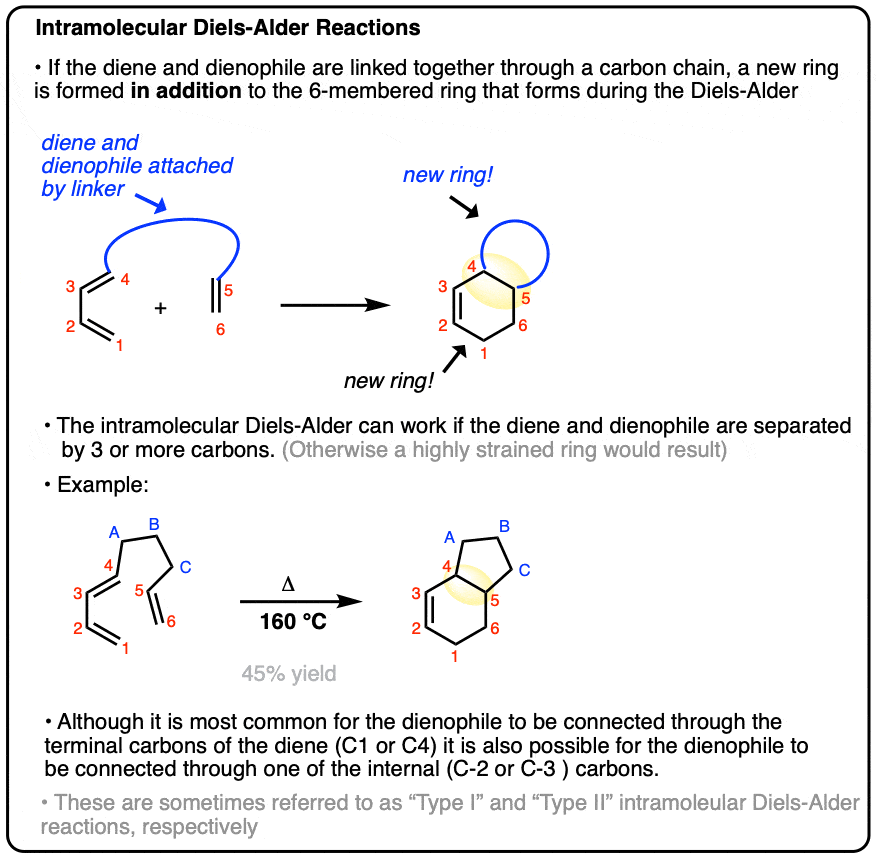
Table of Contents
- The Intramolecular Version Of The Diels-Alder Reaction
- Intramolecular Diels Alder Reactions Work Best When Forming Five And Six Membered Rings
- The Key Patterns Of The Intramolecular Diels-Alder Reaction Are No Different From The “Regular” Diels-Alder Reaction
- The Stereochemistry Of The Dienophile Is Preserved
- How To Draw The Product Of An Intramolecular Diels Alder Reaction
- More Practice In Drawing Intramolecular Diels-Alder Reactions
- What About “Endo” and “Exo” In Intramolecular Diels-Alder Reactions?
- Summary: The Intramolecular Diels-Alder Reaction
- Notes
- Appendix: Type 1 and Type 2 Intramolecular Diels-Alder Reactions, Transannular Diels-Alder Reactions
- Quiz Yourself!
- (Advanced) References and Further Reading
1. The Intramolecular Version Of The Diels-Alder Reaction
As we’ve seen, the Diels-Alder reaction is an awesome process where a “diene” combines with a “dienophile” to give a new six-membered ring.
We form two new C–C sigma bonds and a C–C pi bond, and break three C–C pi bonds.

You can think of the (electron-rich) diene as the “nucleophile” and the (electron-poor) dienophile as the “electrophile” here.
As we’ve seen, when a nucleophile and an electrophile are present on the same molecule, rings can form. We’ve seen it most recently with the Williamson ether synthesis, which gives cyclic ethers.
The Diels-Alder reaction is no different. If the diene and dienophile are connected together by a chain of carbon atoms, it’s possible for them to come in close enough proximity for a reaction to occur.

Intramolecular reactions take some getting used to. Note that the pattern of bonds that form and break is exactly the same! The only thing that’s changed here is that since the diene and dienophile are on the same molecule, a ring will form.
The analogy I like to use is that of a belt or loop, where the nucleophile (the buckle) joins together with the electrophile (the notch).
Any time a new ring is formed, some restrictions apply. The nucleophile and electrophile have to be able to “find” each other in the first place. If the carbon chain isn’t long enough, no reaction will occur.
This is true of belts, too. Imagine cutting a notch in a belt about an inch away from the buckle. You can’t bring the buckle close enough to the notch for it to close! There just isn’t enough slack.
The same is true for intramolecular Diels-Alder reactions in the case where the diene and the dienophile are separated by just one or two carbons. The diene and dienophile are just too close together. The reaction doesn’t work.
(For what it’s worth, the product would also contain a new cyclopropane or cyclobutane ring so this would introduce significant ring strain! ) [Note 1]
However, when the chain length is three or more, the intramolecular Diels-Alder reaction is possible!
2. Intramolecular Diels Alder Reactions Work Best When Forming Five And Six Membered Rings
When the diene and dienophile are separated by three carbons, a new five-membered ring will form in addition to the six-membered ring. Here’s a real-life example.2

Again, note – the bonds that form and the bonds that break are exactly the same as above.
The intramolecular Diels-Alder reaction also works well when the diene and dienophile are separated by four carbons. In this case a new six-membered ring will form, in addition to the six-membered ring obtained in every Diels-Alder reaction. Buy one, get one free!

[It’s actually possible to design a Diels-Alder reaction that results in three new rings! Note]
Of course, the tether can be extended even further to give even larger rings, but five- and six- membered rings tend to be the “sweet spot”. Forming 8-11 membered rings can be tricky for (advanced – transannular strain) reasons we won’t go into today. Additionally, as the chain gets longer, the diene and the dienophile aren’t held together as closely (something we call, “effective concentration”) so the reaction rates are lower.
For an example of a large ring synthesis (from the laboratory of Nobel Laureate Prof E.J. Corey) see this footnote7 .
3. The Key Patterns Of The Intramolecular Diels-Alder Reaction Are No Different From The “Regular” Diels-Alder Reaction
Now let’s start making things a bit more exotic. But keep your eye on the ball! The bonds formed and bonds broken will not change!
For example here is an example of a Diels-Alder containing a nitrogen:

Notice how the nitrogen isn’t the least bit involved in the bonds that form and break here. Try not to get distracted! [Note 2]
4. The Stereochemistry Of The Dienophile Is Preserved
Recall that in the intermolecular (i.e. “regular”) Diels-Alder if we have a dienophile with a trans– orientation about the double bond, that trans– relationship is transferred to the new six-membered ring.
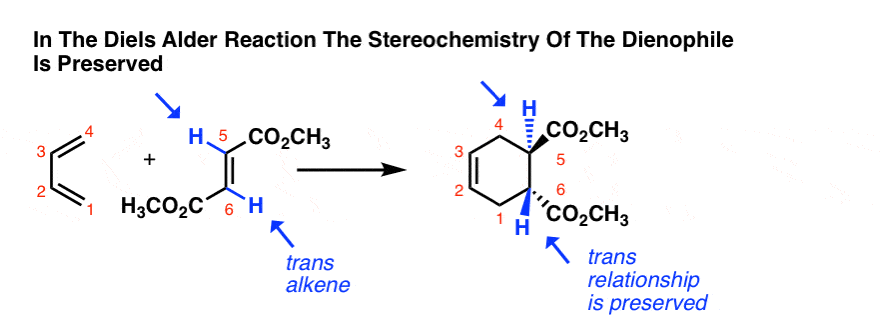
Things are no different with the intramolecular Diels-Alder!
The stereochemistry of the dienophile is preserved. Here we’ve got a dienophile with a cis geometry, and note that this relationship is preserved in the Diels-Alder product.

Likewise, although we won’t present an example, the “outside” groups on the diene will end up on the same face of the new six-membered ring. We saw that previously where we covered stereochemistry in the Diels-Alder.
5. How To Draw The Product Of An Intramolecular Diels Alder Reaction
So far, we’ve been “cheating” a bit. You might have noticed that each of these examples was set up very nicely and the Diels-Alder reaction is pretty obvious.
That won’t always be the case. Sometimes you might be given a long chain polyene that you have to draw the Diels-Alder product for, such as in the example below.

So what do you do?
The first rule of intramolecular reactions is to number all the carbons. (Trust me on this.)
OK. Now what?
Every Diels-Alder reaction follows the the same bond forming/bond breaking pattern. So I suggest you start with the “template” of the Diels-Alder first and then connect the two with a vague-looking “loop”. (It’s OK, we’ll fill in the missing details in the next step.)
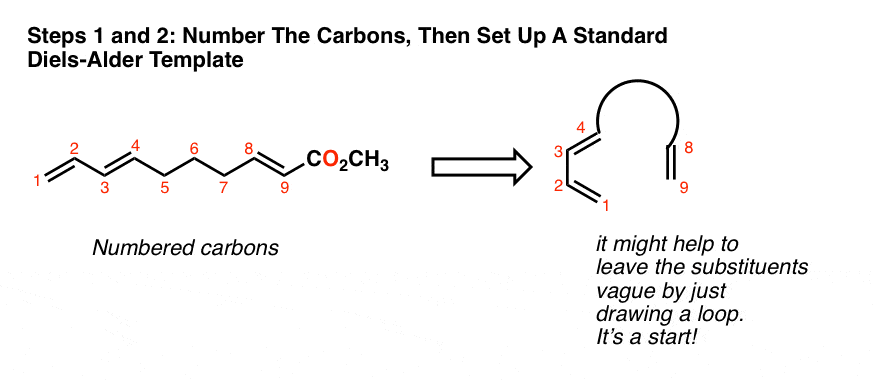
Then, since you have so nicely numbered all the carbons, it shouldn’t be too hard to go back and fill in all the parts you missed. In this case we note that we have 3 linking carbons so we will get a new 5-membered ring. Also, we need to attach the CO2CH3 to what we’re calling, C-9.
At this point go ahead and draw in the product of the Diels-Alder reaction. It’s OK to draw the ugly version first, then clean it up.

The last step is to draw in the stereochemistry. The dienophile is trans, so that means that this relationship needs to be preserved in the product. It’s OK to draw the ester as a wedge and the C-7 as a dash (or vice versa – that will imply the enantiomer). Alternatively placing an H as a wedge will imply that the other substituent is a dash (or vice versa).
That’s it. Not so bad if you follow the steps!
6. More Practice In Drawing Intramolecular Diels-Alder Reactions
Let’s do another one. Try to draw the product of this Diels-Alder reaction. I’ve already numbered it for you.

A helpful hint: it mght help to set up your Diels-Alder in the normal way with just a “loop” for the linker at first. Remember, if there are 3 carbons linking the diene with the dienophile, a new five-membered ring will be formed. If there are 4 linking carbons, a new six-membered ring will be formed.
The answer to this quiz along with other quiz questions can be found in the “Quiz Yourself” section below.
7. What About “Endo” and “Exo” In Intramolecular Diels-Alder Reactions?
Since everything that applies to an intermolecular Diels-Alder reaction also applies to an intramolecular Diels-Alder, you might be wondering: does “endo” and “exo” apply to the intramolecular Diels-Alder reaction too?
Well, yes.
[If you look closely, you might notice that several examples above have chiral centers where the stereochemistry is undefined. That’s on purpose just to keep things simple. ]
The factors that affect the geometry of the new ring are subtle, and I don’t think it’s appropriate to go into them today. The Alder “Endo” rule doesn’t apply as cleanly to intramolecular Diels-Alder reactions as it does to intermolecular reactions.
If you are curious about this subject, I highly recommend starting with the work of Prof. Ken Houk in the references below2 , as well as this (open access) review by Prof. Alex Fallis of University of Ottawa.
8. Summary: The Intramolecular Diels-Alder Reaction
Here’s what we’ve covered about the intramolecular Diels-Alder reaction:
- The pattern of bonds broken and bonds formed is the same as in any other Diels-Alder, as is the stereochemistry patterns in the diene and the dienophile.
- We developed a system for drawing the product of an intramolecular Diels-Alder reaction when the starting material is drawn as an open chain: 1) Number the carbons 2) Draw a Diels-Alder template 3) Fill in the rest of the molecule 4) Draw out the Diels-Alder reaction (draw the ugly version first) 5) Clean up the product 6) Adjust stereochemistry of the dienophile (if necessary)
Don’t get psyched out. Take your time, methodically number your carbons, follow the key patterns, and breathe.
Notes
Related Articles
- Regiochemistry In The Diels-Alder Reaction
- The Cope and Claisen Rearrangements
- Electrocyclic Reactions
- Electrocyclic Ring Opening And Closure (2) – Six (or Eight) Pi Electrons
- The Retro Diels-Alder Reaction
- Intramolecular Friedel-Crafts Reactions
- Intramolecular Reactions of Alcohols and Ethers
- Diels Alder Practice Problems (MOC Membership)
Note 1. Look at the products that would result from the intramolecular Diels-Alder reaction of these molecules. Even if the diene and the dienophile could reach, the products would be very strained!
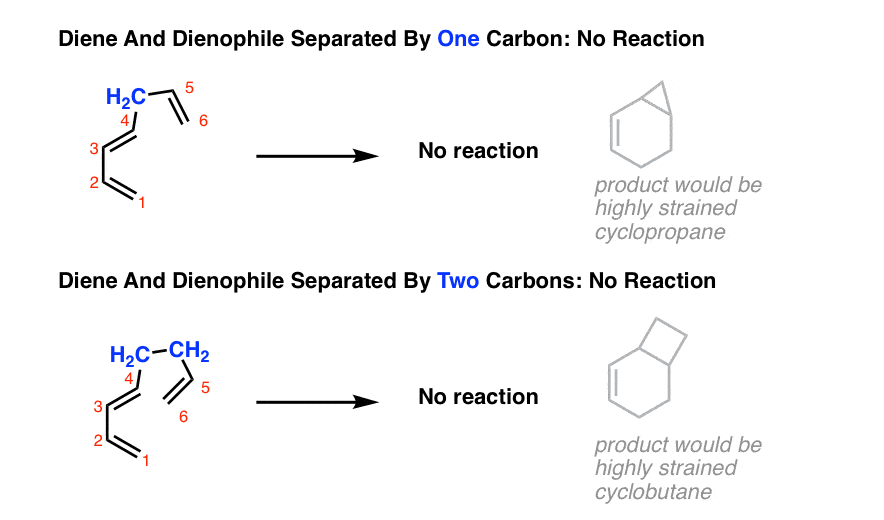
Note 2. These types of dienes (o-quinodimethanes) are unstable and highly reactive. Notice how the Diels-Alder product is an aromatic ring? That gives this reaction a tremendous driving force.
“Type 1” and “Type 2” Intramolecular Diels Alder Reactions
The intramolecular Diels-Alder reaction has seen tremendous use in complex target molecule synthesis.
All the examples in the article above show the diene and dienophile attached where the tether is on one of the termini of the diene.
These are sometimes called, “Type 1” intramolecular Diels-Alder reactions – the most common kind, in other words.
However, there is another way to do it: link the diene and dienophile together through carbon #2 of the diene.
These are referred to as “Type 2” intramolecular Diels-Alder reactions.

The result will be a bridged bicyclic product, which can sometimes be helpful in synthesis. Here’s a (simplified) example from Prof. Tohru Fukuyama’s synthesis of the fungal metabolite CP-263,114.Ref

Note also that the product has a bridgehead double bond – but that’s OK since the parent ring is 9-membered, and bridehead alkene stability roughly correlates to the stability of the parent trans-cycloalkene (trans-cyclononene is stable and isolable)
“Transannular” Intramolecular Diels-Alder Reactions
All of the examples above had the diene and the dienophile attached via a linker on one end of the diene. This results in two rings – the 6 membered ring of the Diels Alder, plus the new ring. It’s also possible to have the diene and dienophile attached through both ends of the diene. In this case three new rings will form. This is referred to as a transannular Diels-Alder reaction5 .
Here is an example of a transannular Diels-Alder reaction resulting in a synthesis the steroid nucleus.

An incredible example of a transannular Diels-Alder came up in Prof. Erik Sorensen’s (Princeton) synthesis of the hexacyclic beast below which was a double transannular intramolecular Diels-Alder reaction! This actually happens in nature!

This process was discovered concurrently (and independently) by the laboratory of Prof. David A. Evans of Harvard University.
Quiz Yourself!
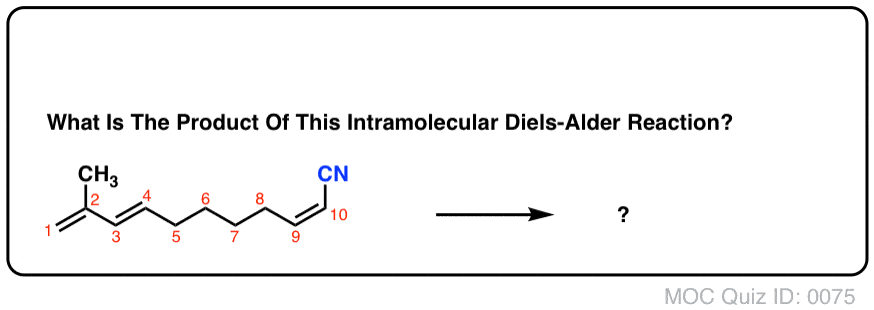 Click to Flip
Click to Flip
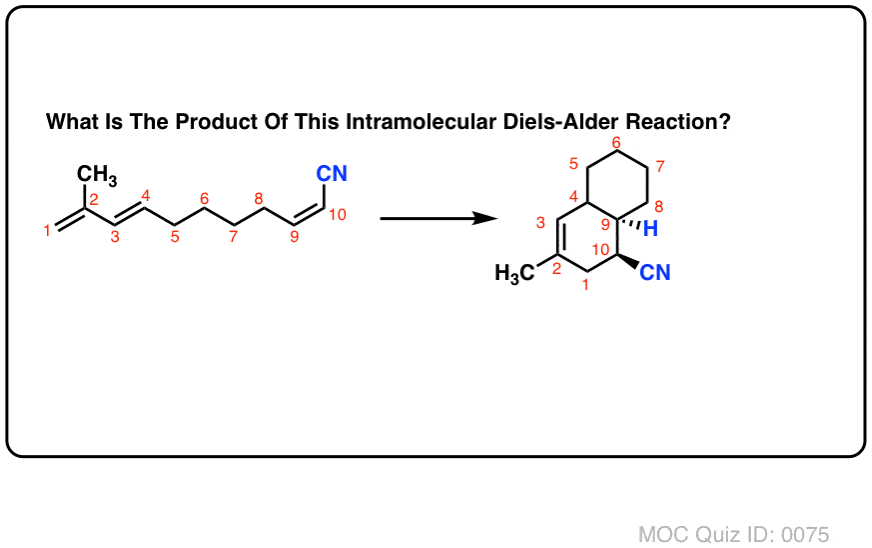
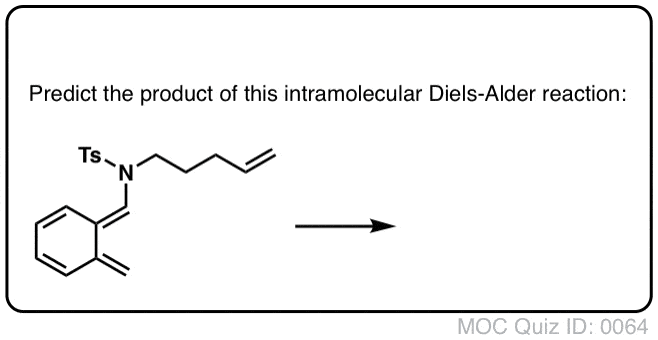 Click to Flip
Click to Flip
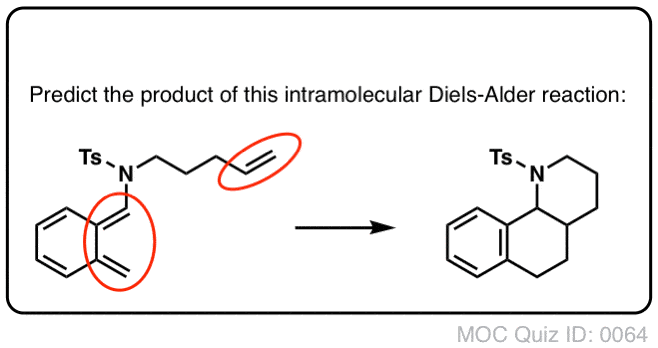
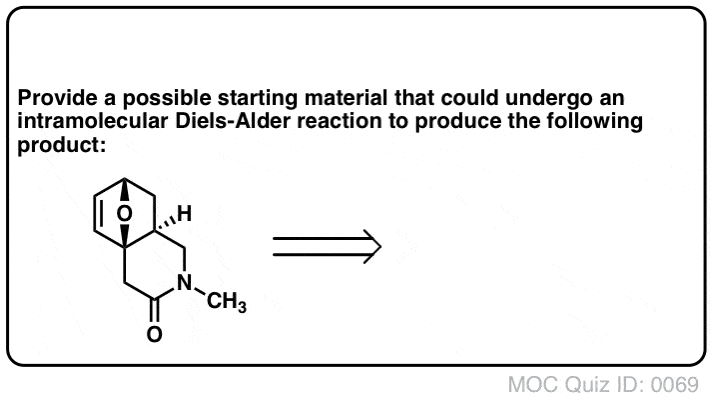 Click to Flip
Click to Flip

(Advanced) References and Further Reading
After the initial report of the Diels-Alder reaction in 1928, it took several decades for an intramolecular version to appear. Alder reported an intramolecular Diels-Alder reaction in 1956, but it wasn’t until the early 1960’s that significant progress began to be made.
- Synthetic Transformation of Natural Products. I. 1-Methylene-2,10-methano-5,5,9-trimethyldecahydronaphthalene
Brieger, G.
Journal of the American Chemical Society 1963 85 (23), 3783-3784
DOI: 10.1021/ja00906a015
One of the earliest published examples of an intramolecular Diels-Alder reaction, toward the construction of the longifolene skeleton. f - Intramolecular diels-alder reactions of 1,3,8-nonatriene and 1,3,9-decatriene
Yi-Tsong Lin, K. N. Houk
Tetrahedron Letters, 1985, 26 (19) 2269-2272
DOI: 10.1016/S0040-4039(00)95071-8 - Intramolecular Diels-Alder reactions of ethyl 2,4,9-decatrienoate and 2,4,10-undecatrienoate
Yi-Tsong Lin, K. N. Houk
Tetrahedron Letters, 1985, 26 (21) 2517-2520
DOI: 10.1016/S0040-4039(00)98825-7
These two classic studies are aimed at investigating some of the simplest possible intramolecular Diels-Alder reactions and examining the subtle factors that affect the stereochemistry of the new ring junction.
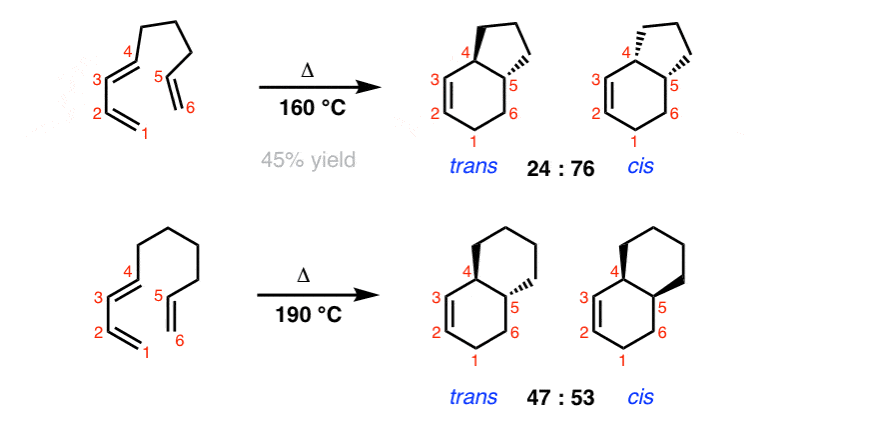
- The Type 2 Intramolecular Diels-Alder Reaction: Synthesis and Chemistry of Bridgehead Alkenes
Bear, B. R.; Sparks, S. M.; Shea, K. J.
Angew. Chem. Int. Ed. Engl. 2001, 40, 820-49
DOI: 10.1002/1521-3773(20010302)40:5%3C820::AID-ANIE820%3E3.0.CO;2-F
A review on “Type 2” intramolecular Diels-Alder reactions by Prof. Kenneth J. Shea (University of California, Irvine). - The Transannular Diels-Alder Strategy: Applications to Total Synthesis
Marsault, E.; Toro, A.; Nowak, P.; Deslongchamps, P.
Tetrahedron 2001, 57, 4243-60
DOI: 10.1016/S0040-4020(01)00121-1
Prof. Pierre Deslongchamps (U. de Sherbrooke) has been a pioneer in developing the transannular Diels-Alder reaction. - An Enantioselective Synthesis of FR182877 Provides a Chemical Rationalization of Its Structure and Affords Multigram Quantities of Its Direct Precursor
Christopher D. Vanderwal,David A. Vosburg,Sven Weiler, and, and Erik J. SorensenJournal of the American Chemical Society 2003 125 (18), 5393-5407
DOI: 10.1021/ja021472b
Epic double intramolecular Diels-Alder cascade reaction resulting in the complex hexacyclic molecule (+)-FR182877. - Formation of Macrocyclic Structures By Use Of The Diels-Alder Reaction
Corey, E. J. ; Petrzilka, M.
Tetrahedron Letters, 1975, 2537.
DOI: 10.1016/S0040-4039(00)75172-0
Formation of a new 12-membered ring using an intramolecular Diels-Alder reaction from the laboratory of Prof. E.J. Corey (Harvard)
00 General Chemistry Review
01 Bonding, Structure, and Resonance
- How Do We Know Methane (CH4) Is Tetrahedral?
- Hybrid Orbitals and Hybridization
- How To Determine Hybridization: A Shortcut
- Orbital Hybridization And Bond Strengths
- Sigma bonds come in six varieties: Pi bonds come in one
- A Key Skill: How to Calculate Formal Charge
- The Four Intermolecular Forces and How They Affect Boiling Points
- 3 Trends That Affect Boiling Points
- How To Use Electronegativity To Determine Electron Density (and why NOT to trust formal charge)
- Introduction to Resonance
- How To Use Curved Arrows To Interchange Resonance Forms
- Evaluating Resonance Forms (1) - The Rule of Least Charges
- How To Find The Best Resonance Structure By Applying Electronegativity
- Evaluating Resonance Structures With Negative Charges
- Evaluating Resonance Structures With Positive Charge
- Exploring Resonance: Pi-Donation
- Exploring Resonance: Pi-acceptors
- In Summary: Evaluating Resonance Structures
- Drawing Resonance Structures: 3 Common Mistakes To Avoid
- How to apply electronegativity and resonance to understand reactivity
- Bond Hybridization Practice
- Structure and Bonding Practice Quizzes
- Resonance Structures Practice
02 Acid Base Reactions
- Introduction to Acid-Base Reactions
- Acid Base Reactions In Organic Chemistry
- The Stronger The Acid, The Weaker The Conjugate Base
- Walkthrough of Acid-Base Reactions (3) - Acidity Trends
- Five Key Factors That Influence Acidity
- Acid-Base Reactions: Introducing Ka and pKa
- How to Use a pKa Table
- The pKa Table Is Your Friend
- A Handy Rule of Thumb for Acid-Base Reactions
- Acid Base Reactions Are Fast
- pKa Values Span 60 Orders Of Magnitude
- How Protonation and Deprotonation Affect Reactivity
- Acid Base Practice Problems
03 Alkanes and Nomenclature
- Meet the (Most Important) Functional Groups
- Condensed Formulas: Deciphering What the Brackets Mean
- Hidden Hydrogens, Hidden Lone Pairs, Hidden Counterions
- Don't Be Futyl, Learn The Butyls
- Primary, Secondary, Tertiary, Quaternary In Organic Chemistry
- Branching, and Its Affect On Melting and Boiling Points
- The Many, Many Ways of Drawing Butane
- Wedge And Dash Convention For Tetrahedral Carbon
- Common Mistakes in Organic Chemistry: Pentavalent Carbon
- Table of Functional Group Priorities for Nomenclature
- Summary Sheet - Alkane Nomenclature
- Organic Chemistry IUPAC Nomenclature Demystified With A Simple Puzzle Piece Approach
- Boiling Point Quizzes
- Organic Chemistry Nomenclature Quizzes
04 Conformations and Cycloalkanes
- Staggered vs Eclipsed Conformations of Ethane
- Conformational Isomers of Propane
- Newman Projection of Butane (and Gauche Conformation)
- Introduction to Cycloalkanes
- Geometric Isomers In Small Rings: Cis And Trans Cycloalkanes
- Calculation of Ring Strain In Cycloalkanes
- Cycloalkanes - Ring Strain In Cyclopropane And Cyclobutane
- Cyclohexane Conformations
- Cyclohexane Chair Conformation: An Aerial Tour
- How To Draw The Cyclohexane Chair Conformation
- The Cyclohexane Chair Flip
- The Cyclohexane Chair Flip - Energy Diagram
- Substituted Cyclohexanes - Axial vs Equatorial
- Ranking The Bulkiness Of Substituents On Cyclohexanes: "A-Values"
- Cyclohexane Chair Conformation Stability: Which One Is Lower Energy?
- Fused Rings - Cis-Decalin and Trans-Decalin
- Naming Bicyclic Compounds - Fused, Bridged, and Spiro
- Bredt's Rule (And Summary of Cycloalkanes)
- Newman Projection Practice
- Cycloalkanes Practice Problems
05 A Primer On Organic Reactions
- The Most Important Question To Ask When Learning a New Reaction
- Curved Arrows (for reactions)
- Nucleophiles and Electrophiles
- The Three Classes of Nucleophiles
- Nucleophilicity vs. Basicity
- What Makes A Good Nucleophile?
- What Makes A Good Leaving Group?
- 3 Factors That Stabilize Carbocations
- Equilibrium and Energy Relationships
- 7 Factors that stabilize negative charge in organic chemistry
- 7 Factors That Stabilize Positive Charge in Organic Chemistry
- What's a Transition State?
- Hammond's Postulate
- Learning Organic Chemistry Reactions: A Checklist (PDF)
- Introduction to Oxidative Cleavage Reactions
06 Free Radical Reactions
- Free Radical Reactions
- 3 Factors That Stabilize Free Radicals
- Bond Strengths And Radical Stability
- Free Radical Initiation: Why Is "Light" Or "Heat" Required?
- Initiation, Propagation, Termination
- Monochlorination Products Of Propane, Pentane, And Other Alkanes
- Selectivity In Free Radical Reactions
- Selectivity in Free Radical Reactions: Bromination vs. Chlorination
- Halogenation At Tiffany's
- Allylic Bromination
- Bonus Topic: Allylic Rearrangements
- In Summary: Free Radicals
- Synthesis (2) - Reactions of Alkanes
- Free Radicals Practice Quizzes
07 Stereochemistry and Chirality
- Types of Isomers: Constitutional Isomers, Stereoisomers, Enantiomers, and Diastereomers
- How To Draw The Enantiomer Of A Chiral Molecule
- How To Draw A Bond Rotation
- Introduction to Assigning (R) and (S): The Cahn-Ingold-Prelog Rules
- Assigning Cahn-Ingold-Prelog (CIP) Priorities (2) - The Method of Dots
- Enantiomers vs Diastereomers vs The Same? Two Methods For Solving Problems
- Assigning R/S To Newman Projections (And Converting Newman To Line Diagrams)
- How To Determine R and S Configurations On A Fischer Projection
- The Meso Trap
- Optical Rotation, Optical Activity, and Specific Rotation
- Optical Purity and Enantiomeric Excess
- What's a Racemic Mixture?
- Chiral Allenes And Chiral Axes
- Stereochemistry Practice Problems and Quizzes
08 Substitution Reactions
- Nucleophilic Substitution Reactions - Introduction
- Two Types of Nucleophilic Substitution Reactions
- The SN2 Mechanism
- Why the SN2 Reaction Is Powerful
- The SN1 Mechanism
- The Conjugate Acid Is A Better Leaving Group
- Comparing the SN1 and SN2 Reactions
- Polar Protic? Polar Aprotic? Nonpolar? All About Solvents
- Steric Hindrance is Like a Fat Goalie
- Common Blind Spot: Intramolecular Reactions
- Substitution Practice - SN1
- Substitution Practice - SN2
09 Elimination Reactions
- Elimination Reactions (1): Introduction And The Key Pattern
- Elimination Reactions (2): The Zaitsev Rule
- Elimination Reactions Are Favored By Heat
- Two Elimination Reaction Patterns
- The E1 Reaction
- The E2 Mechanism
- E1 vs E2: Comparing the E1 and E2 Reactions
- Antiperiplanar Relationships: The E2 Reaction and Cyclohexane Rings
- Bulky Bases in Elimination Reactions
- Comparing the E1 vs SN1 Reactions
- Elimination (E1) Reactions With Rearrangements
- E1cB - Elimination (Unimolecular) Conjugate Base
- Elimination (E1) Practice Problems And Solutions
- Elimination (E2) Practice Problems and Solutions
10 Rearrangements
11 SN1/SN2/E1/E2 Decision
- Identifying Where Substitution and Elimination Reactions Happen
- Deciding SN1/SN2/E1/E2 (1) - The Substrate
- Deciding SN1/SN2/E1/E2 (2) - The Nucleophile/Base
- SN1 vs E1 and SN2 vs E2 : The Temperature
- Deciding SN1/SN2/E1/E2 - The Solvent
- Wrapup: The Key Factors For Determining SN1/SN2/E1/E2
- Alkyl Halide Reaction Map And Summary
- SN1 SN2 E1 E2 Practice Problems
12 Alkene Reactions
- E and Z Notation For Alkenes (+ Cis/Trans)
- Alkene Stability
- Alkene Addition Reactions: "Regioselectivity" and "Stereoselectivity" (Syn/Anti)
- Stereoselective and Stereospecific Reactions
- Hydrohalogenation of Alkenes and Markovnikov's Rule
- Hydration of Alkenes With Aqueous Acid
- Rearrangements in Alkene Addition Reactions
- Halogenation of Alkenes and Halohydrin Formation
- Oxymercuration Demercuration of Alkenes
- Hydroboration Oxidation of Alkenes
- m-CPBA (meta-chloroperoxybenzoic acid)
- OsO4 (Osmium Tetroxide) for Dihydroxylation of Alkenes
- Palladium on Carbon (Pd/C) for Catalytic Hydrogenation of Alkenes
- Cyclopropanation of Alkenes
- A Fourth Alkene Addition Pattern - Free Radical Addition
- Alkene Reactions: Ozonolysis
- Summary: Three Key Families Of Alkene Reaction Mechanisms
- Synthesis (4) - Alkene Reaction Map, Including Alkyl Halide Reactions
- Alkene Reactions Practice Problems
13 Alkyne Reactions
- Acetylides from Alkynes, And Substitution Reactions of Acetylides
- Partial Reduction of Alkynes With Lindlar's Catalyst
- Partial Reduction of Alkynes With Na/NH3 To Obtain Trans Alkenes
- Alkyne Hydroboration With "R2BH"
- Hydration and Oxymercuration of Alkynes
- Hydrohalogenation of Alkynes
- Alkyne Halogenation: Bromination and Chlorination of Alkynes
- Oxidation of Alkynes With O3 and KMnO4
- Alkenes To Alkynes Via Halogenation And Elimination Reactions
- Alkynes Are A Blank Canvas
- Synthesis (5) - Reactions of Alkynes
- Alkyne Reactions Practice Problems With Answers
14 Alcohols, Epoxides and Ethers
- Alcohols - Nomenclature and Properties
- Alcohols Can Act As Acids Or Bases (And Why It Matters)
- Alcohols - Acidity and Basicity
- The Williamson Ether Synthesis
- Ethers From Alkenes, Tertiary Alkyl Halides and Alkoxymercuration
- Alcohols To Ethers via Acid Catalysis
- Cleavage Of Ethers With Acid
- Epoxides - The Outlier Of The Ether Family
- Opening of Epoxides With Acid
- Epoxide Ring Opening With Base
- Making Alkyl Halides From Alcohols
- Tosylates And Mesylates
- PBr3 and SOCl2
- Elimination Reactions of Alcohols
- Elimination of Alcohols To Alkenes With POCl3
- Alcohol Oxidation: "Strong" and "Weak" Oxidants
- Demystifying The Mechanisms of Alcohol Oxidations
- Protecting Groups For Alcohols
- Thiols And Thioethers
- Calculating the oxidation state of a carbon
- Oxidation and Reduction in Organic Chemistry
- Oxidation Ladders
- SOCl2 Mechanism For Alcohols To Alkyl Halides: SN2 versus SNi
- Alcohol Reactions Roadmap (PDF)
- Alcohol Reaction Practice Problems
- Epoxide Reaction Quizzes
- Oxidation and Reduction Practice Quizzes
15 Organometallics
- What's An Organometallic?
- Formation of Grignard and Organolithium Reagents
- Organometallics Are Strong Bases
- Reactions of Grignard Reagents
- Protecting Groups In Grignard Reactions
- Synthesis Problems Involving Grignard Reagents
- Grignard Reactions And Synthesis (2)
- Organocuprates (Gilman Reagents): How They're Made
- Gilman Reagents (Organocuprates): What They're Used For
- The Heck, Suzuki, and Olefin Metathesis Reactions (And Why They Don't Belong In Most Introductory Organic Chemistry Courses)
- Reaction Map: Reactions of Organometallics
- Grignard Practice Problems
16 Spectroscopy
- Degrees of Unsaturation (or IHD, Index of Hydrogen Deficiency)
- Conjugation And Color (+ How Bleach Works)
- Introduction To UV-Vis Spectroscopy
- UV-Vis Spectroscopy: Absorbance of Carbonyls
- UV-Vis Spectroscopy: Practice Questions
- Bond Vibrations, Infrared Spectroscopy, and the "Ball and Spring" Model
- Infrared Spectroscopy: A Quick Primer On Interpreting Spectra
- IR Spectroscopy: 4 Practice Problems
- 1H NMR: How Many Signals?
- Homotopic, Enantiotopic, Diastereotopic
- Diastereotopic Protons in 1H NMR Spectroscopy: Examples
- 13-C NMR - How Many Signals
- Liquid Gold: Pheromones In Doe Urine
- Natural Product Isolation (1) - Extraction
- Natural Product Isolation (2) - Purification Techniques, An Overview
- Structure Determination Case Study: Deer Tarsal Gland Pheromone
17 Dienes and MO Theory
- What To Expect In Organic Chemistry 2
- Are these molecules conjugated?
- Conjugation And Resonance In Organic Chemistry
- Bonding And Antibonding Pi Orbitals
- Molecular Orbitals of The Allyl Cation, Allyl Radical, and Allyl Anion
- Pi Molecular Orbitals of Butadiene
- Reactions of Dienes: 1,2 and 1,4 Addition
- Thermodynamic and Kinetic Products
- More On 1,2 and 1,4 Additions To Dienes
- s-cis and s-trans
- The Diels-Alder Reaction
- Cyclic Dienes and Dienophiles in the Diels-Alder Reaction
- Stereochemistry of the Diels-Alder Reaction
- Exo vs Endo Products In The Diels Alder: How To Tell Them Apart
- HOMO and LUMO In the Diels Alder Reaction
- Why Are Endo vs Exo Products Favored in the Diels-Alder Reaction?
- Diels-Alder Reaction: Kinetic and Thermodynamic Control
- The Retro Diels-Alder Reaction
- The Intramolecular Diels Alder Reaction
- Regiochemistry In The Diels-Alder Reaction
- The Cope and Claisen Rearrangements
- Electrocyclic Reactions
- Electrocyclic Ring Opening And Closure (2) - Six (or Eight) Pi Electrons
- Diels Alder Practice Problems
- Molecular Orbital Theory Practice
18 Aromaticity
- Introduction To Aromaticity
- Rules For Aromaticity
- Huckel's Rule: What Does 4n+2 Mean?
- Aromatic, Non-Aromatic, or Antiaromatic? Some Practice Problems
- Antiaromatic Compounds and Antiaromaticity
- The Pi Molecular Orbitals of Benzene
- The Pi Molecular Orbitals of Cyclobutadiene
- Frost Circles
- Aromaticity Practice Quizzes
19 Reactions of Aromatic Molecules
- Electrophilic Aromatic Substitution: Introduction
- Activating and Deactivating Groups In Electrophilic Aromatic Substitution
- Electrophilic Aromatic Substitution - The Mechanism
- Ortho-, Para- and Meta- Directors in Electrophilic Aromatic Substitution
- Understanding Ortho, Para, and Meta Directors
- Why are halogens ortho- para- directors?
- Disubstituted Benzenes: The Strongest Electron-Donor "Wins"
- Electrophilic Aromatic Substitutions (1) - Halogenation of Benzene
- Electrophilic Aromatic Substitutions (2) - Nitration and Sulfonation
- EAS Reactions (3) - Friedel-Crafts Acylation and Friedel-Crafts Alkylation
- Intramolecular Friedel-Crafts Reactions
- Nucleophilic Aromatic Substitution (NAS)
- Nucleophilic Aromatic Substitution (2) - The Benzyne Mechanism
- Reactions on the "Benzylic" Carbon: Bromination And Oxidation
- The Wolff-Kishner, Clemmensen, And Other Carbonyl Reductions
- More Reactions on the Aromatic Sidechain: Reduction of Nitro Groups and the Baeyer Villiger
- Aromatic Synthesis (1) - "Order Of Operations"
- Synthesis of Benzene Derivatives (2) - Polarity Reversal
- Aromatic Synthesis (3) - Sulfonyl Blocking Groups
- Birch Reduction
- Synthesis (7): Reaction Map of Benzene and Related Aromatic Compounds
- Aromatic Reactions and Synthesis Practice
- Electrophilic Aromatic Substitution Practice Problems
20 Aldehydes and Ketones
- What's The Alpha Carbon In Carbonyl Compounds?
- Nucleophilic Addition To Carbonyls
- Aldehydes and Ketones: 14 Reactions With The Same Mechanism
- Sodium Borohydride (NaBH4) Reduction of Aldehydes and Ketones
- Grignard Reagents For Addition To Aldehydes and Ketones
- Wittig Reaction
- Hydrates, Hemiacetals, and Acetals
- Imines - Properties, Formation, Reactions, and Mechanisms
- All About Enamines
- Breaking Down Carbonyl Reaction Mechanisms: Reactions of Anionic Nucleophiles (Part 2)
- Aldehydes Ketones Reaction Practice
21 Carboxylic Acid Derivatives
- Nucleophilic Acyl Substitution (With Negatively Charged Nucleophiles)
- Addition-Elimination Mechanisms With Neutral Nucleophiles (Including Acid Catalysis)
- Basic Hydrolysis of Esters - Saponification
- Transesterification
- Proton Transfer
- Fischer Esterification - Carboxylic Acid to Ester Under Acidic Conditions
- Lithium Aluminum Hydride (LiAlH4) For Reduction of Carboxylic Acid Derivatives
- LiAlH[Ot-Bu]3 For The Reduction of Acid Halides To Aldehydes
- Di-isobutyl Aluminum Hydride (DIBAL) For The Partial Reduction of Esters and Nitriles
- Amide Hydrolysis
- Thionyl Chloride (SOCl2) And Conversion of Carboxylic Acids to Acid Halides
- Diazomethane (CH2N2)
- Carbonyl Chemistry: Learn Six Mechanisms For the Price Of One
- Making Music With Mechanisms (PADPED)
- Carboxylic Acid Derivatives Practice Questions
22 Enols and Enolates
- Keto-Enol Tautomerism
- Enolates - Formation, Stability, and Simple Reactions
- Kinetic Versus Thermodynamic Enolates
- Aldol Addition and Condensation Reactions
- Reactions of Enols - Acid-Catalyzed Aldol, Halogenation, and Mannich Reactions
- Claisen Condensation and Dieckmann Condensation
- Decarboxylation
- The Malonic Ester and Acetoacetic Ester Synthesis
- The Michael Addition Reaction and Conjugate Addition
- The Robinson Annulation
- Haloform Reaction
- The Hell–Volhard–Zelinsky Reaction
- Enols and Enolates Practice Quizzes
23 Amines
- The Amide Functional Group: Properties, Synthesis, and Nomenclature
- Basicity of Amines And pKaH
- 5 Key Basicity Trends of Amines
- The Mesomeric Effect And Aromatic Amines
- Nucleophilicity of Amines
- Alkylation of Amines (Sucks!)
- Reductive Amination
- The Gabriel Synthesis
- Some Reactions of Azides
- The Hofmann Elimination
- The Hofmann and Curtius Rearrangements
- The Cope Elimination
- Protecting Groups for Amines - Carbamates
- The Strecker Synthesis of Amino Acids
- Introduction to Peptide Synthesis
- Reactions of Diazonium Salts: Sandmeyer and Related Reactions
- Amine Practice Questions
24 Carbohydrates
- D and L Notation For Sugars
- Pyranoses and Furanoses: Ring-Chain Tautomerism In Sugars
- What is Mutarotation?
- Reducing Sugars
- The Big Damn Post Of Carbohydrate-Related Chemistry Definitions
- The Haworth Projection
- Converting a Fischer Projection To A Haworth (And Vice Versa)
- Reactions of Sugars: Glycosylation and Protection
- The Ruff Degradation and Kiliani-Fischer Synthesis
- Isoelectric Points of Amino Acids (and How To Calculate Them)
- Carbohydrates Practice
- Amino Acid Quizzes
25 Fun and Miscellaneous
- A Gallery of Some Interesting Molecules From Nature
- Screw Organic Chemistry, I'm Just Going To Write About Cats
- On Cats, Part 1: Conformations and Configurations
- On Cats, Part 2: Cat Line Diagrams
- On Cats, Part 4: Enantiocats
- On Cats, Part 6: Stereocenters
- Organic Chemistry Is Shit
- The Organic Chemistry Behind "The Pill"
- Maybe they should call them, "Formal Wins" ?
- Why Do Organic Chemists Use Kilocalories?
- The Principle of Least Effort
- Organic Chemistry GIFS - Resonance Forms
- Reproducibility In Organic Chemistry
- What Holds The Nucleus Together?
- How Reactions Are Like Music
- Organic Chemistry and the New MCAT
26 Organic Chemistry Tips and Tricks
- Common Mistakes: Formal Charges Can Mislead
- Partial Charges Give Clues About Electron Flow
- Draw The Ugly Version First
- Organic Chemistry Study Tips: Learn the Trends
- The 8 Types of Arrows In Organic Chemistry, Explained
- Top 10 Skills To Master Before An Organic Chemistry 2 Final
- Common Mistakes with Carbonyls: Carboxylic Acids... Are Acids!
- Planning Organic Synthesis With "Reaction Maps"
- Alkene Addition Pattern #1: The "Carbocation Pathway"
- Alkene Addition Pattern #2: The "Three-Membered Ring" Pathway
- Alkene Addition Pattern #3: The "Concerted" Pathway
- Number Your Carbons!
- The 4 Major Classes of Reactions in Org 1
- How (and why) electrons flow
- Grossman's Rule
- Three Exam Tips
- A 3-Step Method For Thinking Through Synthesis Problems
- Putting It Together
- Putting Diels-Alder Products in Perspective
- The Ups and Downs of Cyclohexanes
- The Most Annoying Exceptions in Org 1 (Part 1)
- The Most Annoying Exceptions in Org 1 (Part 2)
- The Marriage May Be Bad, But the Divorce Still Costs Money
- 9 Nomenclature Conventions To Know
- Nucleophile attacks Electrophile
27 Case Studies of Successful O-Chem Students
- Success Stories: How Corina Got The The "Hard" Professor - And Got An A+ Anyway
- How Helena Aced Organic Chemistry
- From a "Drop" To B+ in Org 2 – How A Hard Working Student Turned It Around
- How Serge Aced Organic Chemistry
- Success Stories: How Zach Aced Organic Chemistry 1
- Success Stories: How Kari Went From C– to B+
- How Esther Bounced Back From a "C" To Get A's In Organic Chemistry 1 And 2
- How Tyrell Got The Highest Grade In Her Organic Chemistry Course
- This Is Why Students Use Flashcards
- Success Stories: How Stu Aced Organic Chemistry
- How John Pulled Up His Organic Chemistry Exam Grades
- Success Stories: How Nathan Aced Organic Chemistry (Without It Taking Over His Life)
- How Chris Aced Org 1 and Org 2
- Interview: How Jay Got an A+ In Organic Chemistry
- How to Do Well in Organic Chemistry: One Student's Advice
- "America's Top TA" Shares His Secrets For Teaching O-Chem
- "Organic Chemistry Is Like..." - A Few Metaphors
- How To Do Well In Organic Chemistry: Advice From A Tutor
- Guest post: "I went from being afraid of tests to actually looking forward to them".
Comments
Comment section